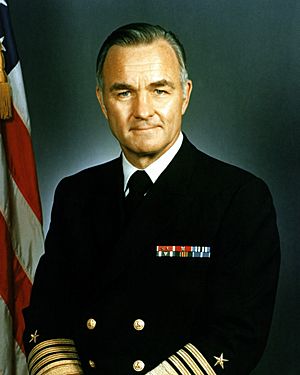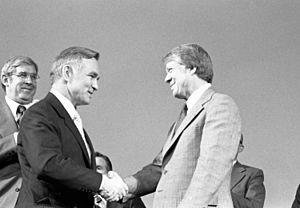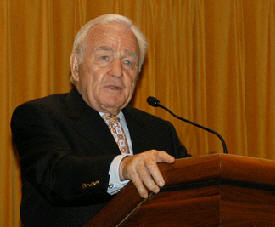Stansfield Turner facts for kids
Quick facts for kids
Admiral
Stansfield Turner
|
|
|---|---|

Admiral Stansfield Turner
(Official US Navy Photo) |
|
| 12th Director of Central Intelligence | |
| In office March 9, 1977 – January 20, 1981 |
|
| President | Jimmy Carter |
| Deputy |
|
| Preceded by | George H. W. Bush |
| Succeeded by | William J. Casey |
| 37th President of the Naval War College | |
| In office June 30, 1972 – August 9, 1974 |
|
| Preceded by | Benedict J. Semmes Jr. |
| Succeeded by | Julien LeBourgeois |
| Personal details | |
| Born | December 1, 1923 Highland Park, Illinois, U.S. |
| Died | January 18, 2018 (aged 94) Redmond, Washington, U.S. |
| Resting place | U.S.N.A. Cemetery 38°59′16″N 76°29′27″W / 38.9877620°N 76.4909403°W |
| Spouses |
|
| Education |
|
| Military service | |
| Allegiance | |
| Branch/service | |
| Years of service | 1946–1978 |
| Rank | |
| Commands |
|
| Battles/wars | |
Stansfield Turner (December 1, 1923 – January 18, 2018) was a high-ranking officer, called an admiral, in the United States Navy. He held many important roles, including leading the Naval War College and commanding a large fleet. He also served as the Supreme Allied Commander for NATO forces in Southern Europe.
One of his most well-known roles was as Director of Central Intelligence (DCI) from 1977 to 1981, under President Jimmy Carter. As DCI, he was in charge of the CIA. Turner made big changes at the CIA, focusing more on collecting information using technology rather than human spies. He also oversaw the CIA's response to major world events like the Iranian Revolution and the Soviet–Afghan War. After leaving the CIA, he wrote books and shared his opinions on government actions.
Contents
Early Life and Education
Stansfield Turner was born in Highland Park, Illinois, on December 1, 1923. His father, Oliver Stansfield Turner, worked in real estate. Stansfield went to Highland Park High School and then attended Amherst College.
In 1943, he joined the U.S. Naval Reserve and was accepted into the United States Naval Academy. He played football there as a guard. Interestingly, Jimmy Carter, who would later become president, was in the same class at the Academy, but they didn't know each other well at the time. Turner earned a degree in electrical engineering in 1946.
After graduating, he became a Rhodes Scholar, which is a special scholarship to study at the University of Oxford in England. He earned a master's degree in Philosophy, Politics, and Economics in 1950. Later, in 1966, he also studied at the Harvard Business School.
Military Career Highlights
After becoming a naval officer, Turner served on several ships, including the escort carrier USS Palau and the light cruiser USS Dayton. After his studies at Oxford, he returned to the Navy. He served as a gunnery officer and operations officer on destroyers during the Korean War.
From 1956 to 1958, he commanded the ocean mine sweeper USS Conquest. He later commanded the destroyer USS Rowan and the guided missile cruiser USS Horne. During his time on the USS Horne, he was involved in combat operations near Vietnam.
As a rear admiral, he led a group of ships, including the aircraft carriers USS Independence and USS John F. Kennedy. This group watched Soviet naval forces in the Mediterranean Sea. He also served as President of the Naval War College from 1972 to 1974. Then, he became Commander of the United States Second Fleet from 1974 to 1975.
In 1975, Turner was promoted to admiral. He became the NATO Commander-in-Chief for Allied Forces Southern Europe in Naples, Italy. He held this important international role until he was appointed to lead the CIA in 1977. Admiral Turner retired from the Navy on December 31, 1978.
Leading the Central Intelligence Agency
In 1977, President Jimmy Carter chose Stansfield Turner to be the Director of Central Intelligence. This was a very important job, putting him in charge of the CIA. President Carter wanted to make changes to the intelligence agencies. Their reputation had been damaged by past events, including spying on American citizens and international plots.
Turner aimed to update the CIA. He brought in several high-ranking naval officers to help him. He also changed how the CIA collected information. Under his leadership, the CIA started to focus more on using technology and signals (like radio messages) to gather intelligence. This was different from relying mainly on human spies.
In 1979, Turner made a controversial decision to reduce the number of operational positions at the CIA. Many of these were in the part of the agency that dealt with secret human intelligence. He later said he regretted some of these job cuts.
Turner also oversaw the start of Operation Cyclone. This was a CIA program to provide weapons and support to Afghan fighters. These fighters were battling the Soviet Union, which had invaded Afghanistan.
During his time at the CIA, a former employee named Frank Snepp published a book. The book revealed some problems within the U.S. government during the fall of Saigon. Turner believed Snepp had broken a secrecy agreement. The CIA won a court case against Snepp, which meant he had to give up his book profits. This case also set a rule that former CIA employees must get approval before publishing anything about their intelligence work. Later, Turner himself had to follow this rule for his own memoirs.
On March 12, 1980, President Jimmy Carter and Turner honored Tony Mendez. Mendez received the CIA's Intelligence Star for his brave role in helping six U.S. State Department workers escape from Iran. This event is known as the Canadian Caper.
After the CIA
After leaving the CIA in 1981, Stansfield Turner became a speaker, author, and TV commentator. He also served on the boards of several companies. He wrote several books, including Secrecy and Democracy – The CIA in Transition (1985) and Burn Before Reading: Presidents, CIA Directors, and Secret Intelligence (2005). In his last book, he suggested breaking up the CIA into smaller parts.
Turner was very critical of the Bush administration's actions regarding the Iraq War. In 2003, he wrote that many reasons given for the invasion turned out to be wrong. He believed the intelligence didn't show an immediate threat. He also felt that the U.S. had to ask other nations for help, even though it initially wanted to act alone.
In 2004, Turner was one of many retired diplomats and military leaders who publicly stated that the Bush administration didn't understand global issues well. In 2005, he criticized Vice President Dick Cheney for his stance on how U.S. detainees were treated. Turner said he was "embarrassed that the USA has a vice president for torture."
Turner also served on a committee for the Business Leaders for Sensible Priorities. This group aimed to reduce military spending and use that money for things like education, healthcare, and humanitarian aid.
Personal Life and Passing
Stansfield Turner married Patricia Busby Whitney in 1953. They had two children, Laurel and Geoffrey, before their marriage ended in 1984. He then married Eli Karin Gilbert in 1985. Sadly, in 2000, Turner survived a plane crash in Costa Rica that killed his wife and three other people. He was seriously injured in the crash. The cause of the crash was not known. Later, in 2002, Turner married Marion Levitt Weiss.
Stansfield Turner passed away at his home in Redmond, Washington, on January 18, 2018, at the age of 94.
Awards and Honors
Turner received many honors throughout his life. He was an Honorary Fellow at Exeter College, Oxford, where he studied as a Rhodes Scholar.
In 1999, he was inducted as a Laureate of The Lincoln Academy of Illinois. He was also awarded the Order of Lincoln, which is the highest honor given by the State of Illinois. In 1978, he received the Golden Plate Award from the American Academy of Achievement.
Military Medals and Ribbons
| 1st Row | Navy Distinguished Service Medal | Legion of Merit with two gold stars | Bronze Star with Combat "V" | |||||
|---|---|---|---|---|---|---|---|---|
| 2nd Row | Joint Service Commendation Medal | Navy and Marine Corps Commendation Medal with Combat "V" | Navy Meritorious Unit Commendation | China Service Medal | ||||
| 3rd Row | American Campaign Medal | World War II Victory Medal | Navy Occupation Service Medal | National Defense Service Medal with one bronze star | ||||
| 4th Row | Korean Service Medal with two bronze stars | Armed Forces Expeditionary Medal | Korean Presidential Unit Citation | United Nations Service Medal | ||||
Selected Books by Stansfield Turner
- Secrecy and Democracy: The CIA in Transition (1985)
- Terrorism and Democracy (1991)
- Caging the Nuclear Genie: An American Challenge for Global Security (1997)
- Updated edition: Caging the Genies: A Workable Solution for Nuclear, Chemical, and Biological Weapons (1999)
- Burn Before Reading (2005)
See also
 In Spanish: Stansfield Turner para niños
In Spanish: Stansfield Turner para niños



